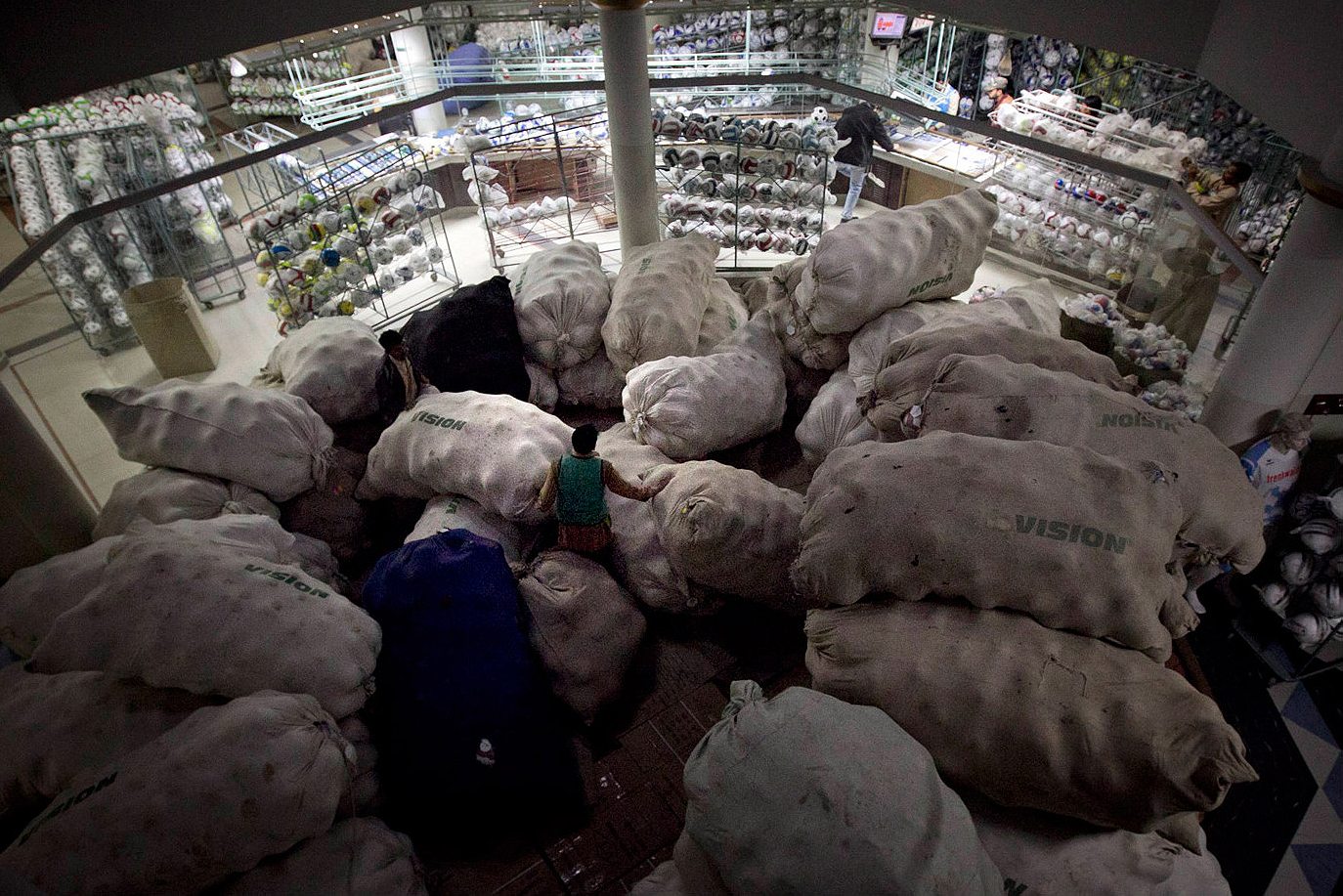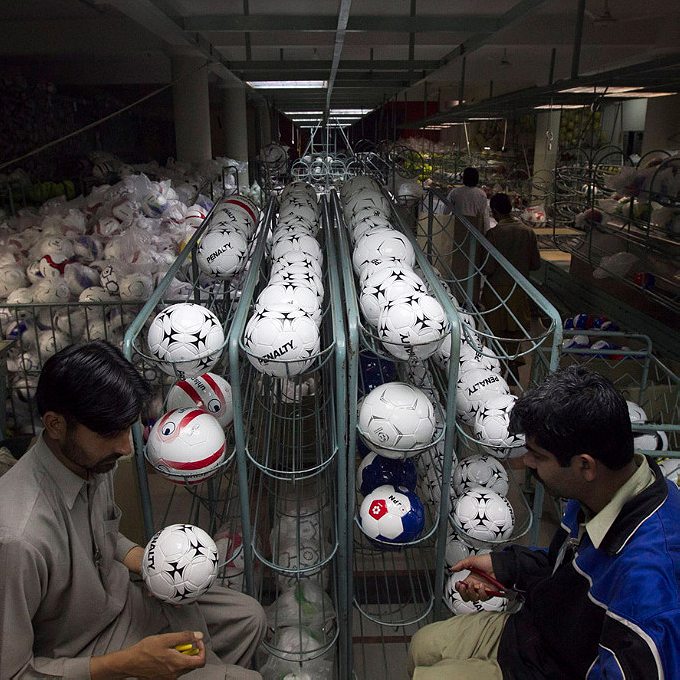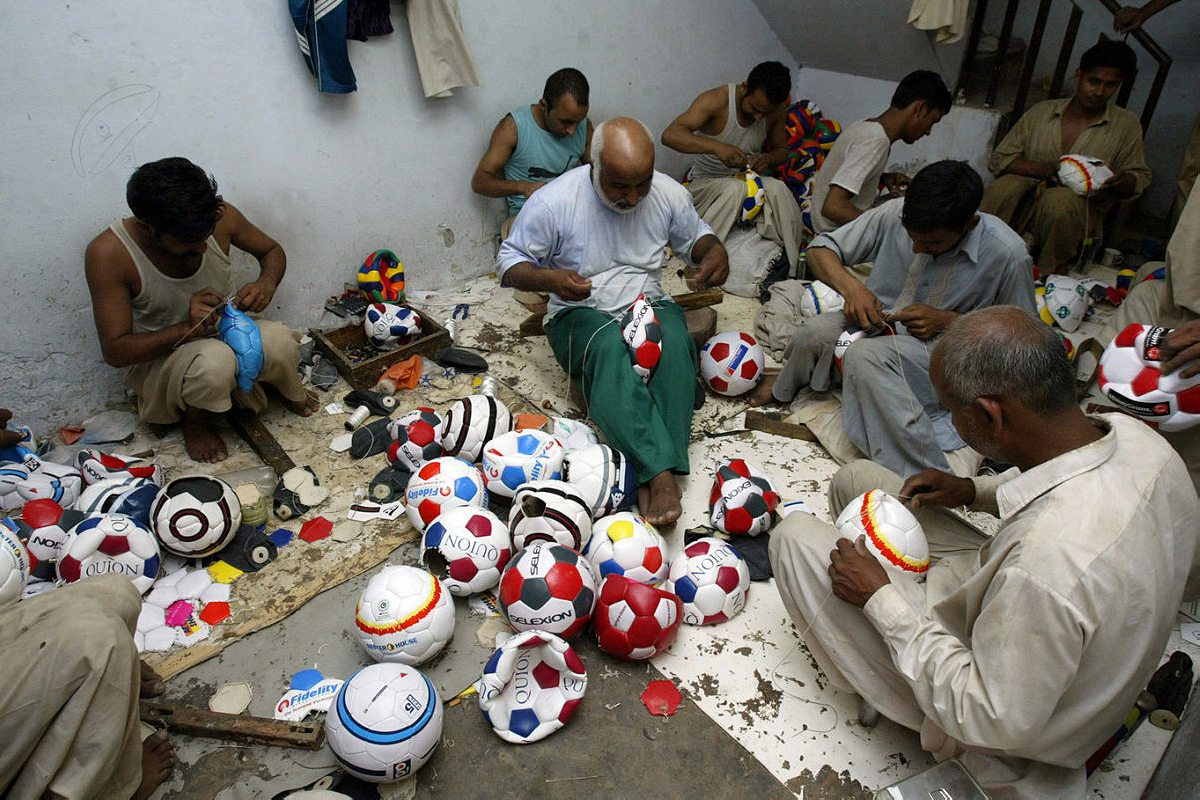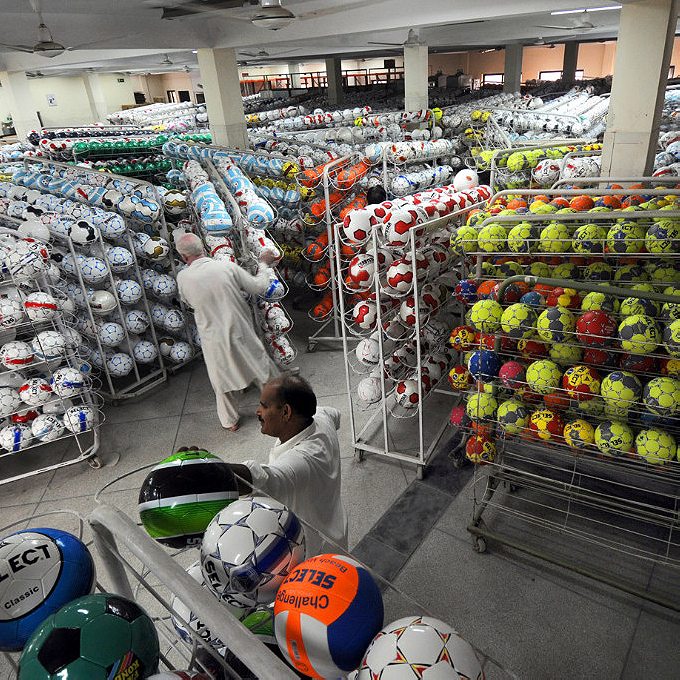How a town in cricket-mad Pakistan became the center of the global soccer ball industry.
When the British ruled India, they had a habit of establishing garrisons in towns across the subcontinent. One of these was located in the ancient town of Sialkot, which now lies in Pakistan’s Punjab province, just shy of the Indian border. To amuse themselves, British soldiers stationed there would, of course, play cricket. But they played football, too, on the many stretches of carefully watered and manicured grass that can still be found across Sialkot’s cantonment area.
According to a local legend, at around the turn of the twentieth century, the British officers managed to puncture their ball during a casual kick-about. Seeking a quick and cheap mend, they enlisted the services of a local Sialkoti cobbler, who readily agreed to try and restore the unusual object to its original full-roundedness. The
attempt proved successful, and the cobbler became a regular source for repairs.
Over time, the cobbler carefully studied the architecture of the ball. Using local leather and practiced knit-work, the enterprising cobbler made several attempts to create a replica. Eventually pleased with the results, he developed a football of his own. When the colonial football enthusiasts next paid a visit, as the local Sialkotis tell the story with relish, he floated a revision to the terms of their deal.
“Instead of getting me to just repair balls,” the cobbler is supposed to have offered, “why don’t you buy them from me as well?” Satisfied with the locally produced alternatives to the footballs they would order from England, the Brits readily agreed. There began the now bustling Sialkoti trade of manufacturing and exporting some of the finest footballs in the world.

Today, Sialkot produces up to 60 million footballs a year, making up 70% of the world’s total production. Over time, the sporting goods industry has spurred other exporters to setup their factories here, producing everything from sporting apparel, to surgical instruments, leather jackets, musical instruments, gloves, guns, and a full range of cutlery.
Sialkot is a town that holds a special place for Pakistanis. It was the birthplace of one of the country’s founders, the poet-philosopher Muhammad Iqbal. It was also home to another famed poet, the dissident leftist Faiz Ahmed Faiz, and other leading writers who now live in both India and Pakistan.
Iqbal’s memory is kept alive across the town. A city square, marked by a Rado clock tower, is named after him. There are portraits of him, looking thoughtfully into the distance, that are carved into walls. Another constant feature are the scars of two hard-fought wars with archrival India. For Pakistanis, the 1965 war between the two neighbors over the disputed territory of Kashmir was sparked by an Indian attack near Sialkot. Six years later, the two countries were pitted against each other once again. Sialkot was the scene of one of the world’s biggest tank battles. Some of the road markings still show that Srinagar, the capital of Indian-administered Kashmir, lies 200 miles away. And old tanks are emplaced in parts of the cantonment as prized memorabilia.
But over time, Sialkot has shaken off that history. It is now an island of prosperity, where Pakistan’s troubles with Islamist militancy and terrorism seem remote. Driving down the smooth paved roads of the Sialkot cantonment, vast high-walled homes line each side. Some boast elaborate designs, including Greek columns and chintzy gold paint. Over time, house prices have soared up to $2 million in some cases. Nearby, there is a range of U.S. franchises, including a large McDonald’s. And a small mall houses boutiques run by Pakistani fashion designers.
The Sialkotis have been lucky to never glimpse a suicide attacker. Since 2007, Pakistan has been scarred by a vicious wave of terrorism that has ravaged the northwest of the country, but also struck deep into the large cities of Lahore, Karachi and the capital Islamabad. But Sialkot has, so far, been spared a single bombing. The only men seen wielding weapons are the brawny soldiers who keep a vigilant eye over the many checkpoints leading out of the cantonment.
THEY NO LONGER SEE THE NEARBY BORDER AS A POINT OF FRICTION WITH AN OLD ENEMY, BUT AS AN OPENING TO THE OUTSIDE WORLD
Many of the wealthiest residents are factory-owners and exporters, a prized source of foreign exchange for the Pakistani economy. Taking advantage of their peaceful circumstances, the denizens of this border town lure billions of dollars each year. They are also a reliable source of tax revenue in a country where scandalously few pay into the national treasury. To keep them happy, the government only holds on to a fraction of their income. In return, they have used their wealth to develop the town’s infrastructure, including a new international airport. They no longer see the nearby border as a point of friction with an old enemy, but as an opening to the outside world.
The most notable of these businessmen is Khawaja Akhtar Masood, the owner of the Forward Sports Factory that produces many of Adidas’ leading footballs. His factory lies on the outskirts of Sialkot, along the Sambrial road, just off the famed Grand Trunk Road, a centuries-old route for commerce that snakes across the north of South Asia, from Kabul, Afghanistan in the west all the way to Dhaka, the capital of Bangladesh. Each morning, brightly painted buses arrive here, driving past fields of rising wheat, to deposit thousands of employees at the well-fortified compound of grey-and-glass buildings.

Masood is a quiet man of medium height who smiles sparingly. He wears a neatly trimmed black beard with a faint moustache and thick glasses that ease the vision of his small eyes. He doesn’t take easily to press interviews, he says in a soft-spoken voice. His family owned a sporting goods company that chiefly produced a range of goods for the Pakistani market, including a line of cricket bats, the most popular item in a country with a fanatic devotion to the colonial sport.
Over time, he recalls, the factory flourished. Their production of footballs steadily improved. And leveraging Pakistan’s ability to produce high-quality hand-stitched footballs, he adds, he was eventually able to tempt Adidas to rely on him as their chief supplier. The handiwork of the east, as many Sialkotis boast, isn’t easily rivaled. Now, the Forward Sports Factory produces over 18,000 footballs a day, including those used in Major League Soccer, the Bundesliga in Germany, and the European Champions’ League.
Masood is plainly proud of the small sporting empire he has built over time. His office walls are adorned with four photographs of him receiving an “export prize” from the former Pakistani Prime Minister, Yousaf Raza Gilani. “There was one year when I wasn’t able to attend the ceremony,” he says, underscoring an unbroken run of recent success. Other symbols of achievement are on proud display across the room, including a slew of certificates and a cabinet full of trophies.
AMONG THE RACK OF FOOTBALLS THAT GREETS VISITORS, THERE IS AN EMPTY SPACE FOR A WORLD CUP BALL
There is, however, one triumph that still eludes him. Among the rack of footballs that greets visitors to his brightly lit office, there is an empty space for a World Cup ball. At the last World Cup, the ball came from China, a close ally of Pakistan’s but, for Masood and other factory-owners in Sialkot, a major threat to their businesses. The Chinese offer cheap raw materials, thrive on the back of an undervalued currency, and also manage to rival even Pakistan’s low cost of labor. Even at the Forward Sports Factory, four-fifths of all raw materials come from China. “It’s cheaper to import from there than use Pakistani raw materials,” Masood explains.
Masood is still hopeful, though, that before long, the World Cup ball will come from Pakistan, too. What Pakistan lacks in scale, he hopes to rival in terms of quality. Around the corner from his office, Masood guides me to the factory’s research and development labs. We walk past plain white walls sometimes adorned with mottos exhorting “success” and “excellence”. There is sealed door that I am shuffled past. “You can’t see that,” he says, in mildly apologetic tones. “It is where are working on the World Cup football.”

Inside the labs, the footballs are put through a rigorous series of elaborate tests before they are deemed fit for mass production. The employees inside are well-trained technical staff who look as if they’ve scrubbed up to perform a complicated surgery. They are all dressed in white lab coats, snap-tight rubber gloves, facemasks, and caps. One technician peers intently into a microscope, apparently inspecting the “contact angle” of the ball. Another watches over a water absorption test. A ball is pressed down repeatedly as it sits on a simulated puddle to see if it can resist soaking in any of the water without losing color or shape.
Other rigors that a ball must pass through include being subject to sharp ultra-violet rays, resisting fungus, retaining air under pressure, and other attempts to test its tensile and fabric strength. In the background, there is a loud, repetitive booming sound, not unlike the constant firing of a canon in wartime. It is coming from the “shooter machine” next door.
The contraption works a bit like a tennis ball machine for lonely practicing types. Except in this case, the ball is fired at immense speed, and without an exploited teen rushing to collect it after it has been hit back across the net. The target is a round metal plate, tilted upwards, with imitation studs protruding from it. After impact, the ball is diverted into a tube from where it rolls back to be fired out once again. A ball has to be able to pass 3,500 of these “shots” to qualify as playable.
The production line itself, located in a separate building, is light on advanced technology. Under a ceiling of dozens of fast-whirring fans, neatly serried rows of employees sit crouched over the desks, frenetically completing assigned tasks — again and again. They are strikingly young, almost all in their 20s and 30s. In some cases their tasks involve gluing some of the tiles together, before they are passed on for the next stage of the assembly process. Others are busy stitching the stiff leather.
A SCOREBOARD KEEPS TRACK OF HOW MANY PRODUCTS HAVE BEEN COMPLETED IN HOW MUCH TIME
The employees have little time off—a half an hour break during the day—and are kept constantly busy. An employee will come and drop off a basket filled with the basic materials. Once they have been tended to, the product is passed up a row to the next person, who will add to it. So it continues, up to the end of the line, where the final product is scrutinized for quality control. A scoreboard keeps track, noting how many products have been completed, in how much time, and how many faulty items have had to be sent back to the end of the queue to be done anew.
Masood insists that his employees are all well taken care of. The lowest paid employee receives minimum wage, he says. In Pakistan, that’s 8,000 rupees, or just below 80 dollars a month. In most workplaces, even that figure is not enforced. There’s medical insurance, a modest pension, and a gift of cash in the event of a son or daughter’s wedding.

Compared to the notorious days of child labor at other factories, when international sporting firms pulled out of Sialkot fearing notoriety, it’s an improvement. In the 1990s, a series of investigations by international bodies found that many of Sialkots footballs were being stitched by young children, some as young as five years old, who were working over 10 hours a day stitching footballs for slave wages. After an intervention by the International Labor Organization, UNICEF, and Save the Children, the Sialkot Chamber of Commerce signed an agreement in 1997 committing to eliminating the use of children as employees. It still continues to be a problem in other parts of Pakistan, though, where up to 25 million children are out of school, mostly working menial jobs to supplement their family’s meager incomes.
At the Forward Sports Factory, though, the entirely adult employees don’t appear too enthusiastic about their jobs. As we walk between the rows, few look up from their workplaces. Most wear a somber look, wearily passing through the repetitive motions of their task. In a section devoted to high-end Adidas match balls, there is a group of attractive young women. Their brightly painted fingernails, which match their outfits, are chipped around the edges from the delicate sewing they carry out.
OVER THE PAST DECADE, WOMEN HAVE BECOME INCREASINGLY VISIBLE IN URBAN WORKPLACES
It is hard to tell whether they are approaching marriage, and supporting their families, or are already married and supplementing the demands of a home that needs more than just the husband’s income. Many refuse to talk to a stranger, pleading they must continue with their work as the stern gaze of a supervisor lingers over them. (The men are marginally more forthcoming; many of them saying how pleased they are to be making balls that they see on TV and that are a source of national pride.)
Over the past decade, women—particularly from the lower-middle class—have become increasingly visible in urban workplaces. Economic imperatives have slowly cast aside conservative social mores that once confined them to a life of cooking, cleaning and mothering at home. It is true across Sialkot’s many factories, where employers draw on women who pass through the now well-attended women’s colleges in the area.
Some cultural obstacles to business still linger. In Pakistan, there are no evening shifts, Masood complains, in another sour contrast with China. The employees often live some distance away, past the vast fields of wheat that dot the rural landscape, in the villages that surround Sialkot. Few are willing to hazard a journey in the dark, abandoning their families and relying on informal transport, to work an extra shift. The only time the factory is at work is during the day.

At the end of each day, the finished balls and the bags are loaded into the back of heavy trucks. As with many of the goods produced in Sialkot, they are only fit for sale abroad. The Forward Sports Factory produces a tiny line of footballs for the local market, but in a country where cricket—not football—is the national passion, there isn’t a professional league that is willing to buy them, either.
WHY DID INDIANS AND PAKISTANIS CHOSE TO ADOPT THE RELATIVELY ELITIST GAME OF CRICKET AND NOT FOOTBALL?
It is a much-vexed question why Indians and Pakistanis chose to adopt the relatively elitist colonial game of cricket and not football as their favored sport. If anything, the rules of football are far simpler and there is no requirement of elaborate equipment. All it needs, really, is a ball. And yet, in the smallest of streets in Pakistan, you can see young children wrap tape around a tennis ball and hurl it over their shoulders to friends holding a wooden bat, probably made elsewhere in Sialkot.
Some have speculated that cricket was adopted early on by South Asian elites at schools modeled on their English variants. From there, the game “trickled down” to the masses, where it is fervently loved by hundreds of millions today. Others wonder if it may have to do with the way cricket rewards the individual talent of a bowler or a batsman in a way that football doesn’t, with its emphasis on a steady team effort to score a goal at the other end of the pitch.
But cricket’s dominance is slowly being chipped away. In Lyari, one of the volatile neighborhoods on the edge Karachi, where the trucks will drive to, football is the game of choice. There is large “People’s Stadium” there. And when Lyari isn’t in the news for gang violence between rival armed groups, it is sometimes affectionately called “Little Brazil” for how the streets light up with enthusiasm when the Latin American football greats play World Cup games.
From Sialkot, the trucks will make a slow, plodding journey across nearly 900 miles of often poorly paved roads. “At Karachi, they are loaded into ships that will take them all over the world,” says Masood. And, one day, he hopes, to the World Cup, too. If that day comes, the crowds in Lyari won’t just be cheering on their favorite teams, but also the fact that they’ll be kicking around a Pakistani ball, made in Sialkot.
